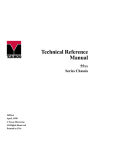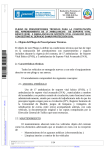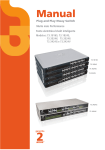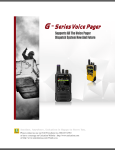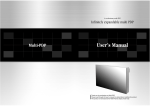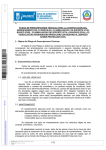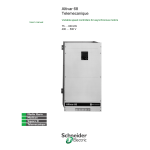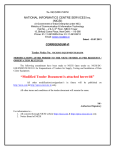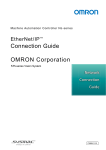Download ZyXEL Communications P-2000W_V2 Troubleshooting guide
Transcript
P-2000W V2 VoIP wireless phone Troubleshooting Guide May 2005 P2000W V2 Troubleshooting Guide Customer Support Please have the following information ready when you contact customer support. • Product model and serial number. • Firmware version of your device. • Brief description of the problem and the steps you took to solve it. • Call server type and vendor. • Packet trace log as instructed on the troubleshooting in this guide. Table of Contents Introduction............................................................................................................................................Page 4 Frequently asked question ....................................................................................................................Page 4 VoIP troubleshooting .............................................................................................................................Page 9 The VoIP Challenge ...............................................................................................................................Page 14 Table of Contents iii P2000W V2 Troubleshooting Guide Introduction The Prestige P2000W V2 is a SIP-based VoIP wireless phone. Sending voice signals over the Internet is called Voice over IP or VoIP. Session Initiated Protocol (SIP) is an internationally recognized standard for implementing SIP. The Prestige allows you to receive Voice over IP calls. You can call any landline or mobile telephones as well as IP telephones. Calls received from IP telephone work exactly as you would expect from traditional telephone service. Although SIP is an internationally recognized standard there are still possibility of interoperability issue occur with ITSP due to vendor’s different interpretation of the SIP standard. Therefore we suggest an interoperability test with the call server is conducted prior to device deployment. Below are some frequently asked question which can help a better understand what is VoIP. Frequently Asked Question What is VoIP? How does VoIP work? Why use IP for voice? What is the relationship between codec and VoIP? What advantage does VoIP can provide? What is the difference between H.323 and SIP? Can H.323 and SIP interoperate with one another? What do I need in order to use SIP? What is voice quality? How are voice quality normally rated? What is codec? What is the relation of codec and VoIP? Which codec should I choose? I have press load default setting from Menu->Setting->Load Default option from the phone cursor but the device seems not fully reset? How do I reset the device to factory default? What is the P2000W V2 supported Codec? What is the P2000W V2 voice codec packet size and packet interval relationship? Can P2000W V2 support outbound proxy? Can P2000W V2 support STUN? All contents copyright (c) 2005 ZyXEL Communications Corporation. P2000W V2 Troubleshooting Guide 1. What is VoIP? Voice over IP is an emerging technology based on open standards of IEEE, fundamentally the Internet Protocol that allows voice data to travel across the Internet. There are many methods to use this technology, the most common and well known are SIP, and H.323. 2. How does VoIP work? Basically VoIP is a technique to send voice information in digital form in discrete packets over digital network rather than by using traditional circuit switch (PSTN). To do so we will need an analog to digital converter on sender side to translate the voice (analog signal) to digital than transmit it, and on the receiver end it will also need an analog to digital converter to covert the digital signal back to analog to the person being called can heard the voice. 3. Why use IP for voice? Traditionally telephony carrier use circuit switching for carrying voice traffic. As circuit switching is designed to carry voice and it does it very well. Than why use IP for voice? As broadband booms, and technology evolve. People now want to communicate through various way not just voice such as email, instant messaging, video and so on. Traditional telephony can not evolve as quickly as the demand and develop new feature on circuit switch takes much time and money. IP is an already exist standard and many type of service already runs on IP, by using IP as a platform integrate service is now possible and low cost where traditional circuit may take long time to achieve. 4. What is the relationship between codec and VoIP? In order to transfer voice (analog signal) over IP it first needs to be digitized. Codec is a technique to digitize analog signal to digital and vice versa. There are various speech codec available and can be used with VoIP each with its advantage and disadvantage. 5. What advantage does VoIP can provide? The advantage of VoIP is it can provide advance services such as joining email, instant messaging, video, voice mail all together. Where current circuit switching (PSTN) can not. All contents copyright (c) 2005 ZyXEL Communications Corporation. P2000W V2 Troubleshooting Guide 6. What is the difference between H.323 and SIP? H.323 and SIP are proposed by different group Session Initiation Protocol (SIP) is a standard introduced by the Internet Engineering Task Force in 1999 to carry voice over IP. Since it was created by the IETF, it approaches voice and multimedia from the Internet, or IP, perspective of view. Where as H.323 emerged around 1996, and as an International Telecommunication Union standard it was designed from a telecommunications perspective. Both standards have the same objective - to enable voice and multimedia convergence with IP protocols. 7. Can H.323 and SIP interoperate with one another? In interoperability between the two, the industry is making slow but sure progress. Interoperability must first happen between vendor implementations of the same protocol (SIP-to-SIP and H.323-to-H.323) and then between protocols. Currently in order for SIP client to talk to H.323 client the ITSP must have a trunking gateway act as a translator between the two protocols without the truncking gateway the two protocols are not able to communicate to one another. 8. What do I need in order to use SIP? The minimum required to use VoIP is as follow. 1. 2. 3. A high-speed Internet connection. This can be a cable modem, or a highspeed network services such as ISDN, DSL or a T-1 link. The need of the bandwidth required will depend on the amount of telephone traffic will be in your network. A PC with VoIP software installed or a hardware VoIP box such as ATA or device like P2000W V2. An account with a VoIP provider such as an ITSP. The account can be configured to recognize your calls automatically, or you can require the users to enter their unique account numbers issued. 9. What is voice quality? Voice quality is how well a person can hear the voice on the opposite end. 10. How are voice quality normally rated? All contents copyright (c) 2005 ZyXEL Communications Corporation. P2000W V2 Troubleshooting Guide Voice quality is most commonly rated through a voice quality metric called the Mean Opinion Score (MOS) which is recommendation by ITU-T. The MOS is a 5 point scale where 5 represent excellent voice quality and 1 represent bad voice quality. 11. What is codec? Codec is an algorithm which converts analog signal into digital signal and vice versa. There are three main types of waveform codec, source codec, and hybrid codec. Each consume different amount of bandwidth and provide different voice quality level. 12. What is the relation of codec and VoIP? As VoIP is general term send voice information in digital form in discrete packets over digital network and this digital network is public network, thus there maybe other packet such data packet uses network at the same time. The codec choose is related to how much bandwidth voice packet will consume. In bandwidth wise aspect the smaller amount of bandwidth used the better. But in voice aspect the higher quality the better. 13. Which codec should I choose? As which codec choose is depending on what codec is supported on both end of the VoIP host. Generally a codec with low bandwidth consumption and high voice quality is a good codec. 14. I have press load default setting from Menu->Setting->Load Default option from the phone cursor but the device seems not fully resetted? 'Load default' is not reset all of the settings. If you press the 'load default', it will reset the Time format, Key lock, Melody, Ring volume, Banner and Vibrator setting to default. 15. How do I reset the device to factory default? To reset P2000W V2 to default including username/password. Please follow the step as below. All contents copyright (c) 2005 ZyXEL Communications Corporation. P2000W V2 Troubleshooting Guide 1. Power off the device. and Left-Selector button until you 2. Keep hold down the Power see <<Load Default>> <<Factory>> words in the LCD screen than release it. 3. Now all setting has been reset to default. 16. What is the P2000W V2 supported Codec? P2000W V2 supported codec are G.729 voice codec G.711u-law voice codec G.711a-law voice codec 17. What is the P2000W V2 voice codec packet size and packet interval relationship? P2000W V2 Voice Frame per Packet V.S. Frame Size G.729 codec Small Medium Large RTP Payload 20 byte 32 byte 60 byte Voice Packet Size 74 byte 86 byte 108 byte Packet Interval 20 ms 30 ms 60 ms G.711 u/a-law codec Small Medium Large RTP Payload 240 byte X 480 byte Voice Packet Size 294 byte X 588 byte Packet Interval 30 ms X 60ms Note: 1. Voice packet size = Ethernet header (14byte) +IP header (20byte) +UDP header (8byte) +RTP header (12byte) +RTP payload. Therefore voice packet size=54byte+RTP payload size. 18. Can P2000W V2 support outbound proxy? P2000W V2 can support outbound proxy. All contents copyright (c) 2005 ZyXEL Communications Corporation. P2000W V2 Troubleshooting Guide 19. Can P2000W V2 support STUN? Yes, P2000W V2 can support STUN. VoIP Troubleshooting Is it a hardware problem? How can I check if problem is cause by NAT or not? If I've confirmed it is not an NAT. What should I do? Unable to register with the SIP server? I can register but can not establish a call? I can make a call but the voice only goes one way not bothway? I can receive a call but the voice only goes one way not bothway? If all the about have been tried, but register still fail or call still have problem to be made behind the NAT what should I do? The support tells me, I may have an interoperabiltiy issue with my ITSP call server. Packet trace is requested by support to analyze the problem. Should I setup the environment and how do I trace the packet? 1. Is it a hardware problem? If following symptoms happen on the P2000W V2 • LCD display does not show “Initializing please wait message” when turn on 1. Make sure the battery of the phone is fully charged. 2. You are using the charger base and power adapter to charge and the power adapter are plugged in to an appropriate power source. 3. Check that the power source is turned on. If the problem persists, you may have a hardware problem. In this case, you should contact your local vendor. • The P2000W V2 sometimes shut down automatically Check if the battery on P2000W V2 is too low. Check that the P2000W V2 is fully charged, if it is fully charge but standby time relatively low the battery may need to be replaced. All contents copyright (c) 2005 ZyXEL Communications Corporation. P2000W V2 Troubleshooting Guide 2. How can I check if problem is cause by NAT or not? There may not be an easy or quick answer to this question. One of the best way to see if the problem is cause by NAT or not is to put P2000W V2 on public network, (With public IP and no NAT) see if it work under such condition. If you it can work on public network but can not work behind NAT than very likely your NAT gateway is not supporting SIP pass-through. In such condition you will need to consult your NAT router vendor for resolution. 3. If I've confirmed it is an NAT problem. What should I do? If you are certain or confirmed the problem is caused by NAT you need to check the following. 1. Check if your NAT router vendor supports SIP pass-through. 2. If the NAT router does not support SIP pass-through, you need to consult your ITSP support if they support SIP outbound proxy. Since different NAT router vendor implement NAT differently. Typically ITSP may provide SIP outbound proxy to resolve NAT pass-through issues as sip proxy does not require the SIP client to do any modification as the server will modify the SIP message content according to the your WAN IP it sees. If your ITSP supports outbound proxy you need to obtain the configuration and configured the outbound proxy location on P2000W V2. 3. As mentioned some NAT may not be SIP friendly. ITSP may support STUN instead of SIP outbound proxy to resolve this issue. To use STUN sip client must support STUN client. How STUN work is when the user register the server will tell SIP client what the WAN IP the server sees from the SIP client and SIP client will use this IP as SIP content to identify its location. 4. Unable to register with the SIP server? If you are unable to register with SIP server. 1. 2. 3. Make sure the Internet is reachable and the SIP register server is reachable. If your register server uses domain name make sure DNS name can be resolved. Make sure the SIP account is correct and the password is correct. Check if there is NAT router before it. If there are NAT router before it follow troubleshooting step above to verify if NAT is the cause of the problem. All contents copyright (c) 2005 ZyXEL Communications Corporation. P2000W V2 Troubleshooting Guide 5. I can register but can not establish a call? If you can register to server but can not make a call very likely there is NAT router before it, please see NAT related question above for tips to troubleshoot. 6. I can make a call but the voice only goes one way not bothway? If you can register to server but can make a call signal establishment but the voice only goes one way very likely there are NAT router before it, please see NAT related question above to tips to troubleshoot. 7. I can receive a call but the voice only goes one way not bothway? If you can register to server but can only make out going call but can not receive incoming calls or the incoming call signal establishment can be made but voice only goes one way very likely there is NAT router before it, please see NAT related question above for tips to troubleshoot. 8. If all the about have been tried, but register still fail or call still have problem to be made behind the NAT what should I do? In such case, please contact your local vendor for support. If they can't help out the problem they will escalate your problem to ZyXEL tech center. To report a problem please prepared below info. 1. Serial number of the device. 2. SIP Call server type and vendor. 3. Your device firmware version and romfile with password. 4. Detail information what you have tried to resolve the problem. All contents copyright (c) 2005 ZyXEL Communications Corporation. P2000W V2 Troubleshooting Guide 9. The support tells me, I may have an interoperability issue with my ITSP call server. Packet trace is requested by support to analyze the problem. How should I setup the environment and how do I trace the packet? In such as you will need to setup your environment similar as scenario A & B to perform packet trace. Make a failed trace and make a successful trace by setting up scenario A & B and send it to support for problem analysis. To perform packet trace the equipment required is as follow 1. PC installed with packet sniffer such "Ethereal" to make the packet capture. Ethereal is a freeware and can be downloaded from www.ethereal.com to perform the packet capturing. 2. Hub and Ethernet cable. 3. Follow the scenario below to capture a working and a none-working trace with Ethereal and send it to support. Scenario A 1. Connect the hub between the P2000W V2 and the front end NAT router with Ethernet cable. 2. Connect the PC with packet sniffer installed to the hub. All contents copyright (c) 2005 ZyXEL Communications Corporation. P2000W V2 Troubleshooting Guide 3. Start packet sniffing software and start packet capturing. 4. Start P2000W V2 and make a complete call from registering to calling a party until problem appears. 5. Stop capturing and save the captured packet in file. Scenario B 1. Connect the hub between the P2000W V2 and the front end CPE with Ethernet cable (Make sure P2000W V2 is with public IP). 2. Connect the PC with packet sniffer installed to the hub. 3. Start packet sniffing software and start packet capturing. 4. Start P2000W V2 and make a complete call from registering to calling a party. 5. Stop capturing once call is established and voice can transferred both way successfully. 6. Save the captured packet in file. All contents copyright (c) 2005 ZyXEL Communications Corporation. P2000W V2 Troubleshooting Guide The corrected working capture should include starting of the call (The SIP invite) to call pickup (The SIP ACK). An example of successful call capture is listed below for your reference. Once both of the above capture is completed, send both captured file to support to analysis the cause. The VoIP challenge SIP is a session initiation protocol which is an application-layer control (signaling) protocol for creating, modifying, and terminating sessions with one or more participants. These sessions include Internet telephone calls, multimedia distribution, and multimedia conferences. For SIP to successfully massively deploy there are several challenge of the real environment it must able to work with. The most common faced problem is NAT pass-through issue and SIP client and call server interoperability issues. When SIP protocol is proposed it self does not consider network environment and other technology that maybe in the deployed network. Since IPv4 IP is insufficient and will soon run out. Thus NAT is very commonly used. Unfortunately from field test many vendor’s NAT are not SIP friendly. All contents copyright (c) 2005 ZyXEL Communications Corporation. P2000W V2 Troubleshooting Guide Fortunately, there are already ways to workaround the NAT for SIP. The most commonly used way is listed below. SIP pass-through support on NAT router (require router vendor implement it). STUN. Outbound Proxy. There are advantage and disadvantage of each technology. For example SIP pass-through on NAT router this requires router vendor implementation. From carrier point of view this does not seem feasible as not every NAT router vendor implement this on their router and they do not have control of which router their customer is using. STUN is a simple traversal of user datagram protocol. It helps to traverse UDP through NAT. STUN allows applications to discover the presence and type of NATs between the host and public Internet. It also provides the ability for application to determine the public IP allocated to the host by NAT. STUN works with many Existing NATs, and does not require special handling from NAT router. As a result it can make SIP pass-through NAT. Please refer to RFC 3489 for more details. The outbound proxy is a normal SIP proxy. You configure your client, the phone or software, to use the proxy for all SIP sessions, just like when you configure your Web browser to use a Web proxy for all Web transactions. In some cases, the outbound proxy is placed alongside the firewall and is the only way to let SIP traffic pass from the internal network to the Internet. For more detail you can refer to RFC 3261 for details. All contents copyright (c) 2005 ZyXEL Communications Corporation.















